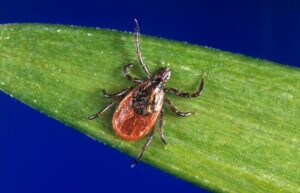NORTH CAROLINA – Ticks thrive in North Carolina during warm weather between April to October so everyone must be careful of contracting Lyme disease, the most commonly transmitted tick-borne illness. Lyme disease is an infection caused by the bacteria Borrelia burgdorferi that is carried by the deer tick, also known as the black-legged tick. The ticks can carry bacteria if they feed on infected animals like mice and deer. Infected deer ticks are found throughout North Carolina. Ticks are active when the temperature is above 45 degrees Fahrenheit. Therefore, milder winters mean that the warmer weather and tick season arrives sooner and remains longer. According to the CDC, almost one-half million Americans are diagnosed with Lyme disease each year.
People who spend time outdoors are at a greater risk of exposure to infected ticks, especially if they have been in grassy or wooded areas. Care needs to be taken during camping, hiking, golfing, working or playing. When a person or an animal brushes tall grass or woods, the tick lets go of the vegetation and crawls on the host. The disease is transmitted to humans through tick bites and by slowly sucking blood from the host. The risk of acquiring the infection is greater if the tick remains attached for more than 36 hours while feeding. In the U.S., Lyme disease is most common in the northeastern, midwestern, and mid-Atlantic states.
The early symptoms and signs of Lyme disease can occur 3 to 30 days after an infected tick bite. A circular bull’s eye rash appears near the bite in more than half of the cases. Early symptoms can include: fever, chills, headache, fatigue, stiff neck, swollen glands, and painful joints and muscles. Most patients can have a complete recovery with a 2 to 4-week course of oral antibiotics within the first 3 weeks.
If left untreated, Lyme disease can progress to severe fatigue, a stiff painful neck, numbness in the arms or legs, and brain fog. Severe headaches, arthritis, joint swelling, and heart and neurologic problems, can occur months and years after the tick bite.
You can protect yourself from getting Lyme disease. Stay out of high grass and wooded areas, and away from dead branches and leaves. Wear protective clothing like a long-sleeved shirt, long pants, and socks. Clothing can be treated with permethrin or may come pre-treated. Dressing in light-colored clothing allows ticks to be seen more easily. Apply tick repellant with DEET. Perform inspection of skin, hair and clothing after being outside and repeat it later in the day. Ticks like to be in the arm pit region, near ears and the hairline, behind knees, in the belly button, between the legs, in hair, and around the waist. You can also remove ‘hard to get’ ticks by taking a bath or a shower within 2 hours after being outside. Wash your clothes and dry them in the dryer, if possible. You can reduce the number of ticks in the yard by mowing the lawn and clearing tall grass, dead leaves, rotten wood and brush. Tick migration can be restricted from recreational areas by placing a 3-foot-wide barrier of wood chips or gravel.
Deer ticks are brownish in color, about the size of a sesame seed and have 8 black legs. Its bite is not painful. They are generally smaller than many common species of ticks. However, the deer tick expands after feeding on the blood of the host.
If a tick is attached to your skin, it is important to remove the whole tick promptly. Pull the tick slowly and steadily with fine-tipped tweezers until the tick lets go. After the tick is removed, clean the bite site with rubbing alcohol and your hands with soap and water. The tick can be immersed in rubbing alcohol and then flushed down the toilet.
You can also get Lyme disease if your pet goes outdoors and brings infected ticks inside your home. The ticks can hide more easily in long-haired pets. Consider keeping pets out of the woods and long grasses during tick season. There are many different topical and chewable preventative medicines for your pets because they can get sick with Lyme disease too. Inspection and tick removal can remove ticks before they get to you.
If you think that you have a tick bite or Lyme disease, you should be seen by a health care provider soon. Early treatment can cure the infection most of the time without any long-term damage.
Listen to the full report below:
Contact: Dr. Dick Needleman, Health reporter, 103.3 AshevilleFM, [email protected]
More Posts for Show: Asheville FM News Hour
